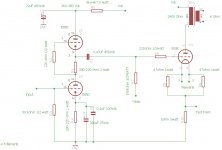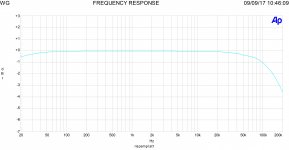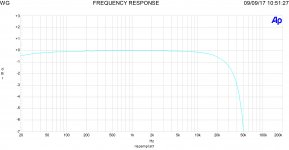6J5 to 6AH4 will give you 120-160x amplification, which is too much. Same with the 6EM7.
30-60x is desirable, depending on how much swing you need for the given circuit. Even needing +/-100V peak, I would want more than 60x amplification factor.
30-60x is desirable, depending on how much swing you need for the given circuit. Even needing +/-100V peak, I would want more than 60x amplification factor.
My background is in music. I have made approximately 50 different types of 300b's over ten years. PP, parallel SE, SE. I can hear the differences when using a 6c45pi/interstage 300b vs a 6sn7/300b capacitor coupled. I understand when the engineer types get into the perfect design and compute the numbers. I do not like the sound of these perfect circuits. They sound like solid state. Tubes distort and it is the distortion that I like. Now I know everyone here will jump on me and that is fine. I still believe that a well trained set of ears may be equal or better than a scope.
6J5 without cathode resistor bypass capacitor and resistively loaded 6AH4 will give gain no more than some 70...perfect!
6EM7 with current source anode load for first triode and current sink cathode load for second triode as cathode follower...gain of some 50 and perfect for fixed bias A2.
Where is creativity??
6EM7 with current source anode load for first triode and current sink cathode load for second triode as cathode follower...gain of some 50 and perfect for fixed bias A2.
Where is creativity??
My background is in music. I have made approximately 50 different types of 300b's over ten years. PP, parallel SE, SE. I can hear the differences when using a 6c45pi/interstage 300b vs a 6sn7/300b capacitor coupled. I understand when the engineer types get into the perfect design and compute the numbers. I do not like the sound of these perfect circuits. They sound like solid state. Tubes distort and it is the distortion that I like. Now I know everyone here will jump on me and that is fine. I still believe that a well trained set of ears may be equal or better than a scope.
Thanks for clarifying.
My background is in music as well (classical).
I like well designed and neutral sounding tube amps over what former member SY would call "effect boxes". These simply are not able to acceptably reproduce the music I like.
I guess we will just have to disagree. I prefer proven designs with modern parts. Creativity is for self indulgence. The combination of classic sound with modern components is perfect and is far more than an effects box. Look up The Absolute Sound product of the year for 2017 phonoo stages and you may change you mind about good listening.
6J5 without cathode resistor bypass capacitor and resistively loaded 6AH4 will give gain no more than some 70...perfect!
6EM7 with current source anode load for first triode and current sink cathode load for second triode as cathode follower...gain of some 50 and perfect for fixed bias A2.
Where is creativity??
I'd just put a high GM triode in front of the 300B and call it done.
Please find in the web the datasheet of 300B of Western Electric.
There you can find a beautiful table with different values for V anode, Zload and current.
Take a care with fixed bias.
Walter
There you can find a beautiful table with different values for V anode, Zload and current.
Take a care with fixed bias.
Walter
In attach a simply but interesting circuit I test in the past.
In fig.1 the frequency response of the input circuit.
20 vout - 450 mV in, gain is 44.
In fig.11 the response at 8 watt out.
Walter
In fig.1 the frequency response of the input circuit.
20 vout - 450 mV in, gain is 44.
In fig.11 the response at 8 watt out.
Walter
Attachments
- Home
- Amplifiers
- Tubes / Valves
- 300B BIAS


